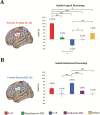Cognitive Enhancement via Network-Targeted Cortico-cortical Associative Brain Stimulation
- PMID: 31667497
- PMCID: PMC7132941
- DOI: 10.1093/cercor/bhz182
Cognitive Enhancement via Network-Targeted Cortico-cortical Associative Brain Stimulation
Erratum in
-
Corrigendum to: Cognitive Enhancement via Network-Targeted Cortico-cortical Associative Brain Stimulation.Cereb Cortex. 2020 Jun 30;30(8):4726. doi: 10.1093/cercor/bhaa131. Cereb Cortex. 2020. PMID: 32391550 Free PMC article. No abstract available.
Abstract
Fluid intelligence (gf) represents a crucial component of human cognition, as it correlates with academic achievement, successful aging, and longevity. However, it has strong resilience against enhancement interventions, making the identification of gf enhancement approaches a key unmet goal of cognitive neuroscience. Here, we applied a spike-timing-dependent plasticity (STDP)-inducing brain stimulation protocol, named cortico-cortical paired associative stimulation (cc-PAS), to modulate gf in 29 healthy young subjects (13 females-mean ± standard deviation, 25.43 years ± 3.69), based on dual-coil transcranial magnetic stimulation (TMS). Pairs of neuronavigated TMS pulses (10-ms interval) were delivered over two frontoparietal nodes of the gf network, based on individual functional magnetic resonance imaging data and in accordance with cognitive models of information processing across the prefrontal and parietal lobe. cc-PAS enhanced accuracy at gf tasks, with parieto-frontal and fronto-parietal stimulation significantly increasing logical and relational reasoning, respectively. Results suggest the possibility of using SPTD-inducing TMS protocols to causally validate cognitive models by selectively engaging relevant networks and manipulating inter-regional temporal dynamics supporting specific cognitive functions.
Keywords: Hebbian plasticity; abstract reasoning; fluid intelligence; logical reasoning; transcranial magnetic stimulation.
© The Author(s) 2019. Published by Oxford University Press. All rights reserved. For permissions, please e-mail: journals.permissions@oup.com.
Figures




References
-
- Alsop DC, Detre JA, Golay X, Günther M, Hendrikse J, Hernandez-Garcia L, Lu H, MacIntosh BJ, Parkes LM, Smits M et al. . 2015. Recommended implementation of arterial spin-labeled perfusion MRI for clinical applications: a consensus of the ISMRM perfusion study group and the European consortium for ASL in dementia. Magn Reson Med. 73:102–116. - PMC - PubMed
-
- Au J, Buschkuehl M, Duncan GJ, Jaeggi SM. 2016. There is no convincing evidence that working memory training is NOT effective: a reply to Melby-Lervåg and Hulme (2015). Psychon Bull Rev. 23:331–337. - PubMed
-
- Bailey DL, Townsend DW, Valk PE, Maisey MN, editors. 2005. In: Positron emission tomography: basic sciences. London: Springer-Verlag.
-
- Barnett SM, Ceci SJ. 2002. When and where do we apply what we learn? A taxonomy for far transfer. Psychol Bull. 128:612–637. - PubMed
-
- Basser PJ, Pajevic S, Pierpaoli C, Duda J, Aldroubi A. 2000. In vivo fiber tractography using DT-MRI data. Magn Reson Med. 44:625–632. - PubMed
Publication types
MeSH terms
Grants and funding
LinkOut - more resources
Full Text Sources

